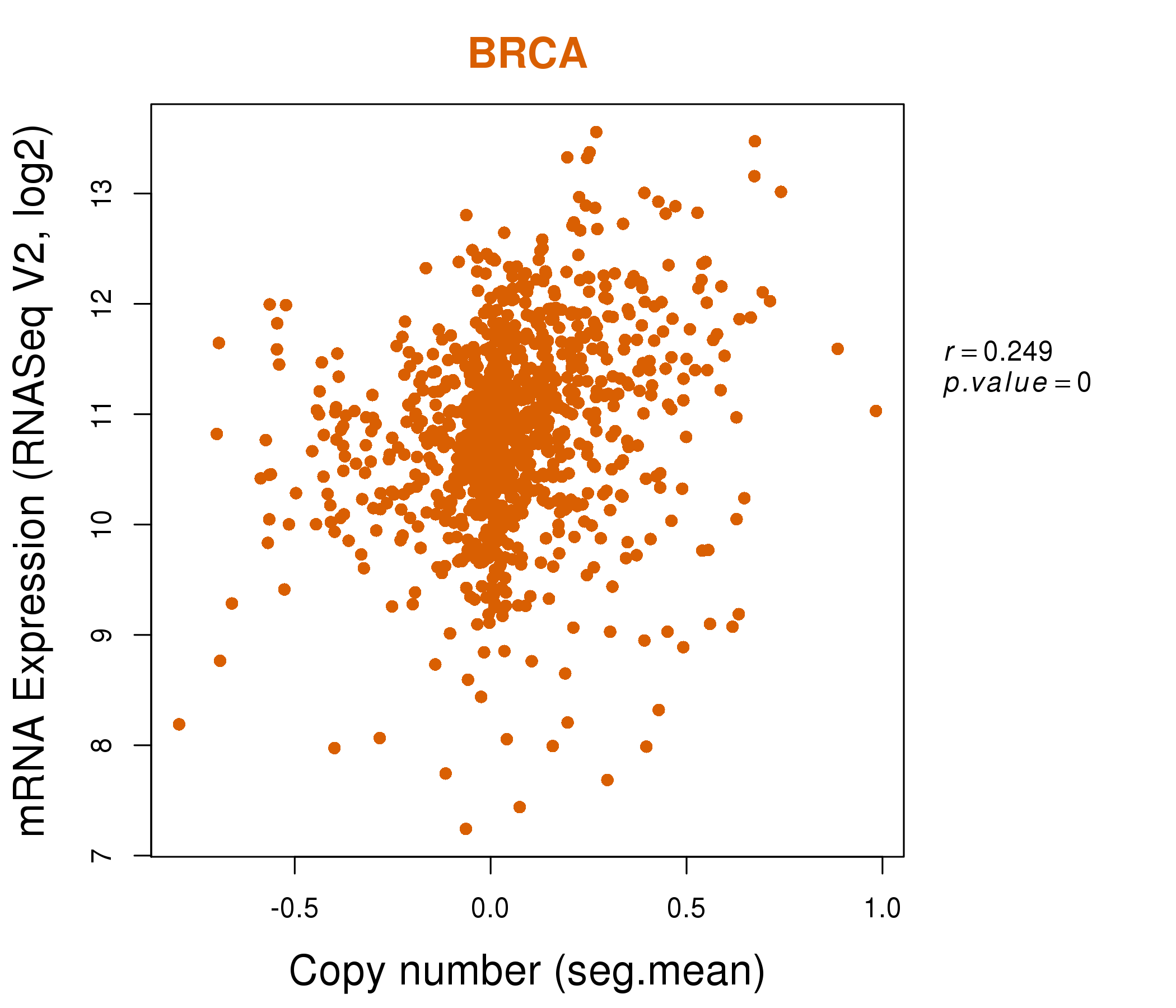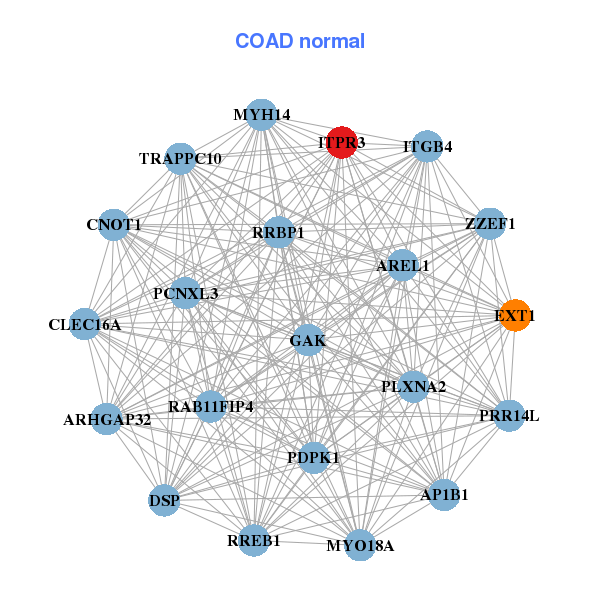|
||||||||||||||||||||||||||||||||||||||||||||||||||||||||||||||||||||||||||||||||||||||||||||||||||||||||||||||||||||||||||||||||||||||||||||||||||||||||||||||||||||||||||||||||||||||||||||||||||||||||||||||||||||||||||||||||||||||||||||||||||||||||||||||||||||||||||||||||||||||||||||||||||||||||||||||||||||||||||
| |
| Phenotypic Information (metabolism pathway, cancer, disease, phenome) |
| |
| |
| Gene-Gene Network Information: Co-Expression Network, Interacting Genes & KEGG |
| |
|
| Gene Summary for ITPR3 |
| Basic gene info. | Gene symbol | ITPR3 |
| Gene name | inositol 1,4,5-trisphosphate receptor, type 3 | |
| Synonyms | IP3R|IP3R3 | |
| Cytomap | UCSC genome browser: 6p21 | |
| Genomic location | chr6 :33589155-33664348 | |
| Type of gene | protein-coding | |
| RefGenes | NM_002224.3, | |
| Ensembl id | ENSG00000096433 | |
| Description | IP3 receptorinositol 1,4,5-triphosphate receptor, type 3inositol 1,4,5-trisphosphate receptor type 3insP3R3type 3 InsP3 receptor | |
| Modification date | 20141207 | |
| dbXrefs | MIM : 147267 | |
| HGNC : HGNC | ||
| Ensembl : ENSG00000096433 | ||
| HPRD : 00926 | ||
| Vega : OTTHUMG00000014532 | ||
| Protein | UniProt: Q14573 go to UniProt's Cross Reference DB Table | |
| Expression | CleanEX: HS_ITPR3 | |
| BioGPS: 3710 | ||
| Gene Expression Atlas: ENSG00000096433 | ||
| The Human Protein Atlas: ENSG00000096433 | ||
| Pathway | NCI Pathway Interaction Database: ITPR3 | |
| KEGG: ITPR3 | ||
| REACTOME: ITPR3 | ||
| ConsensusPathDB | ||
| Pathway Commons: ITPR3 | ||
| Metabolism | MetaCyc: ITPR3 | |
| HUMANCyc: ITPR3 | ||
| Regulation | Ensembl's Regulation: ENSG00000096433 | |
| miRBase: chr6 :33,589,155-33,664,348 | ||
| TargetScan: NM_002224 | ||
| cisRED: ENSG00000096433 | ||
| Context | iHOP: ITPR3 | |
| cancer metabolism search in PubMed: ITPR3 | ||
| UCL Cancer Institute: ITPR3 | ||
| Assigned class in ccmGDB | A - This gene has a literature evidence and it belongs to cancer gene. | |
| References showing role of ITPR3 in cancer cell metabolism | 1. Sumantran VN, Mishra P, Sudhakar N (2015) Microarray analysis of differentially expressed genes regulating lipid metabolism during melanoma progression. Indian J Biochem Biophys 52: 125-131. go to article | |
| Top |
| Phenotypic Information for ITPR3(metabolism pathway, cancer, disease, phenome) |
| Cancer | CGAP: ITPR3 |
| Familial Cancer Database: ITPR3 | |
| * This gene is included in those cancer gene databases. |
|
|
|
|
|
|
| ||||||||||||||||||||||||||||||||||||||||||||||||||||||||||||||||||||||||||||||||||||||||||||||||||||||||||||||||||||||||||||||||||||||||||||||||||||||||||||||||||||||||||||||||||||||||||||||||||||||||||||||||||||||||||||||||||||||||||||||||||||||||||||||||||||||||||||||||||||||||||||||||||||||||||||||||||||
Oncogene 1 | Significant driver gene in | |||||||||||||||||||||||||||||||||||||||||||||||||||||||||||||||||||||||||||||||||||||||||||||||||||||||||||||||||||||||||||||||||||||||||||||||||||||||||||||||||||||||||||||||||||||||||||||||||||||||||||||||||||||||||||||||||||||||||||||||||||||||||||||||||||||||||||||||||||||||||||||||||||||||||||||||||||||||||
| cf) number; DB name 1 Oncogene; http://nar.oxfordjournals.org/content/35/suppl_1/D721.long, 2 Tumor Suppressor gene; https://bioinfo.uth.edu/TSGene/, 3 Cancer Gene Census; http://www.nature.com/nrc/journal/v4/n3/abs/nrc1299.html, 4 CancerGenes; http://nar.oxfordjournals.org/content/35/suppl_1/D721.long, 5 Network of Cancer Gene; http://ncg.kcl.ac.uk/index.php, 1Therapeutic Vulnerabilities in Cancer; http://cbio.mskcc.org/cancergenomics/statius/ |
| REACTOME_INTEGRATION_OF_ENERGY_METABOLISM | |
| OMIM | 147267; gene. |
| Orphanet | |
| Disease | KEGG Disease: ITPR3 |
| MedGen: ITPR3 (Human Medical Genetics with Condition) | |
| ClinVar: ITPR3 | |
| Phenotype | MGI: ITPR3 (International Mouse Phenotyping Consortium) |
| PhenomicDB: ITPR3 | |
| Mutations for ITPR3 |
| * Under tables are showing count per each tissue to give us broad intuition about tissue specific mutation patterns.You can go to the detailed page for each mutation database's web site. |
| - Statistics for Tissue and Mutation type | Top |
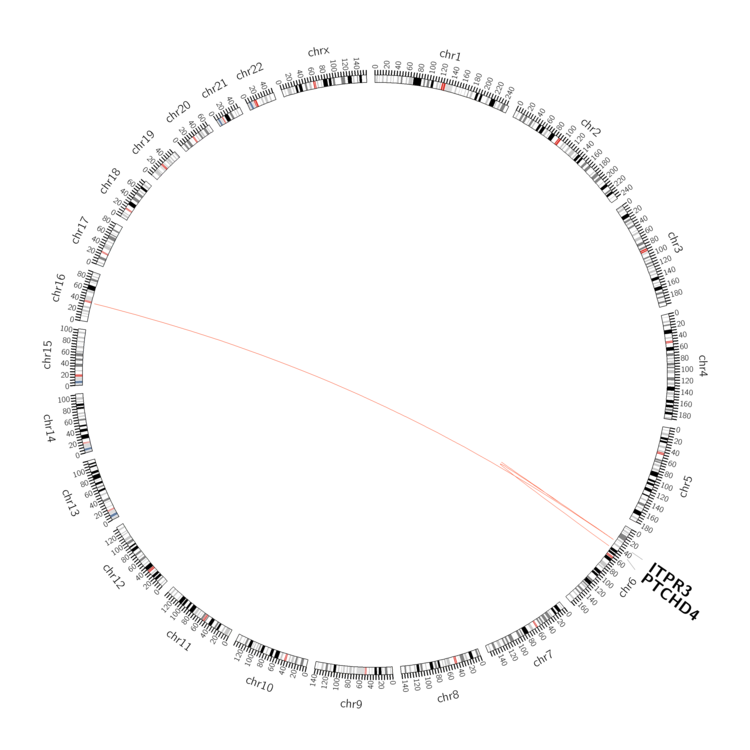 |
| - For Inter-chromosomal Variations |
| * Inter-chromosomal variantions includes 'interchromosomal amplicon to amplicon', 'interchromosomal amplicon to non-amplified dna', 'interchromosomal insertion', 'Interchromosomal unknown type'. |
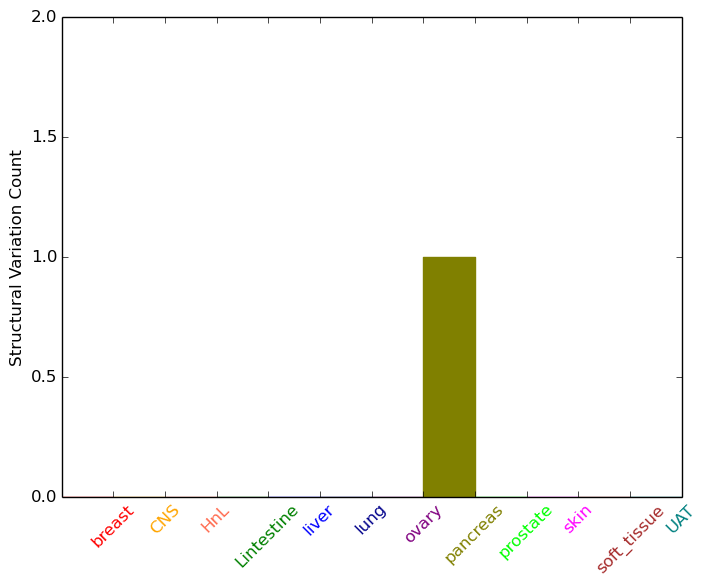 |
| - For Intra-chromosomal Variations |
| * Intra-chromosomal variantions includes 'intrachromosomal amplicon to amplicon', 'intrachromosomal amplicon to non-amplified dna', 'intrachromosomal deletion', 'intrachromosomal fold-back inversion', 'intrachromosomal inversion', 'intrachromosomal tandem duplication', 'Intrachromosomal unknown type', 'intrachromosomal with inverted orientation', 'intrachromosomal with non-inverted orientation'. |
 |
| Sample | Symbol_a | Chr_a | Start_a | End_a | Symbol_b | Chr_b | Start_b | End_b |
| breast | ITPR3 | chr6 | 33606834 | 33606834 | PTCHD4 | chr6 | 47945547 | 47945547 |
| ovary | ITPR3 | chr6 | 33635736 | 33635756 | ITPR3 | chr6 | 33635786 | 33635806 |
| pancreas | ITPR3 | chr6 | 33642332 | 33642352 | chr16 | 35264610 | 35264630 |
| cf) Tissue number; Tissue name (1;Breast, 2;Central_nervous_system, 3;Haematopoietic_and_lymphoid_tissue, 4;Large_intestine, 5;Liver, 6;Lung, 7;Ovary, 8;Pancreas, 9;Prostate, 10;Skin, 11;Soft_tissue, 12;Upper_aerodigestive_tract) |
| * From mRNA Sanger sequences, Chitars2.0 arranged chimeric transcripts. This table shows ITPR3 related fusion information. |
| ID | Head Gene | Tail Gene | Accession | Gene_a | qStart_a | qEnd_a | Chromosome_a | tStart_a | tEnd_a | Gene_a | qStart_a | qEnd_a | Chromosome_a | tStart_a | tEnd_a |
| AA507809 | ITPR3 | 5 | 104 | 6 | 33662805 | 33663532 | ITPR3 | 100 | 278 | 6 | 33661414 | 33662810 | |
| CB306680 | ITPR3 | 18 | 69 | 6 | 33662056 | 33662107 | ITPR3 | 65 | 259 | 6 | 33662251 | 33662444 | |
| BF848867 | ITPR3 | 17 | 229 | 6 | 33658051 | 33658263 | FXR2 | 230 | 328 | 17 | 7499289 | 7504801 | |
| BF762968 | AARS | 1 | 241 | 16 | 70287672 | 70289887 | ITPR3 | 234 | 389 | 6 | 33635631 | 33636336 | |
| BF763529 | ITPR3 | 1 | 131 | 6 | 33648178 | 33648408 | SETD5 | 125 | 357 | 3 | 9516855 | 9517087 | |
| BF954113 | ITPR3 | 17 | 229 | 6 | 33658051 | 33658263 | FXR2 | 230 | 328 | 17 | 7499289 | 7504801 | |
| Top |
| Mutation type/ Tissue ID | brca | cns | cerv | endome | haematopo | kidn | Lintest | liver | lung | ns | ovary | pancre | prost | skin | stoma | thyro | urina | |||
| Total # sample | 1 | 2 | ||||||||||||||||||
| GAIN (# sample) | 1 | 2 | ||||||||||||||||||
| LOSS (# sample) |
| cf) Tissue ID; Tissue type (1; Breast, 2; Central_nervous_system, 3; Cervix, 4; Endometrium, 5; Haematopoietic_and_lymphoid_tissue, 6; Kidney, 7; Large_intestine, 8; Liver, 9; Lung, 10; NS, 11; Ovary, 12; Pancreas, 13; Prostate, 14; Skin, 15; Stomach, 16; Thyroid, 17; Urinary_tract) |
| Top |
|
 |
| Top |
| Stat. for Non-Synonymous SNVs (# total SNVs=199) | (# total SNVs=62) |
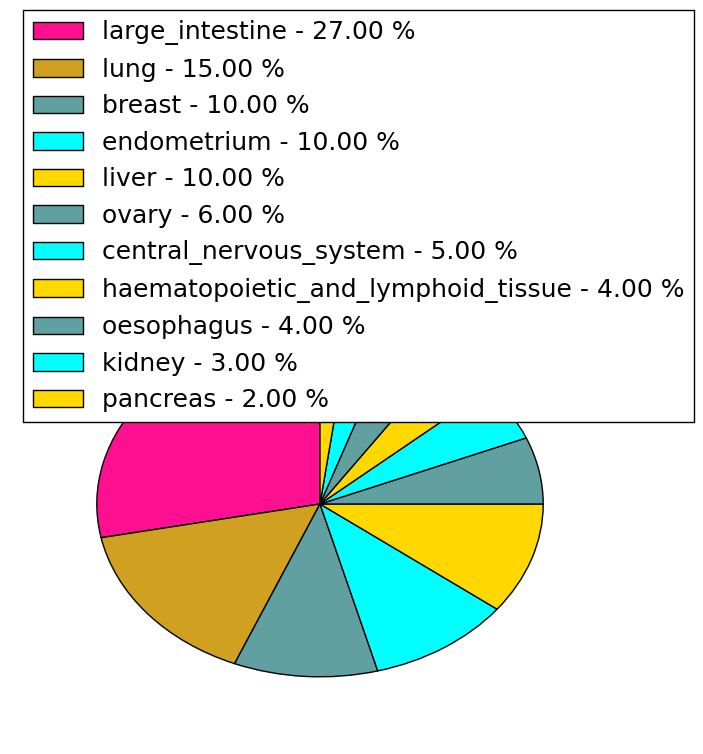 | 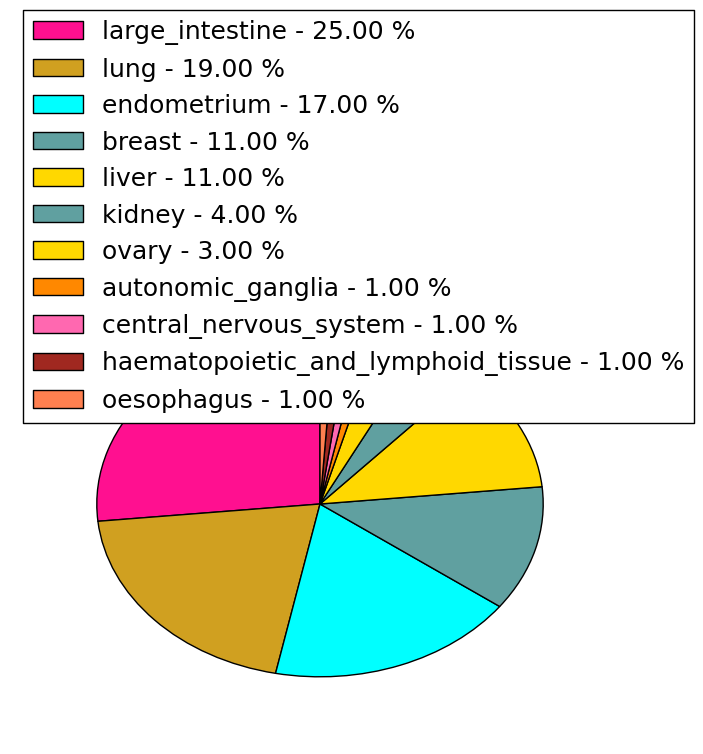 |
(# total SNVs=8) | (# total SNVs=0) |
 |
| Top |
| * When you move the cursor on each content, you can see more deailed mutation information on the Tooltip. Those are primary_site,primary_histology,mutation(aa),pubmedID. |
| GRCh37 position | Mutation(aa) | Unique sampleID count |
| chr6:33660616-33660616 | p.R2524C | 4 |
| chr6:33635629-33635629 | p.E592K | 3 |
| chr6:33648197-33648197 | p.T1439M | 3 |
| chr6:33634933-33634933 | p.R527C | 3 |
| chr6:33653882-33653882 | p.T1907M | 3 |
| chr6:33634906-33634906 | p.V518I | 3 |
| chr6:33638469-33638469 | p.A821A | 3 |
| chr6:33625713-33625713 | p.A96V | 3 |
| chr6:33623571-33623571 | p.N63N | 2 |
| chr6:33631599-33631599 | p.A364T | 2 |
| Top |
|
 |
| Point Mutation/ Tissue ID | 1 | 2 | 3 | 4 | 5 | 6 | 7 | 8 | 9 | 10 | 11 | 12 | 13 | 14 | 15 | 16 | 17 | 18 | 19 | 20 |
| # sample | 7 | 7 | 44 | 8 | 8 | 6 | 1 | 2 | 17 | 7 | 5 | 1 | 15 | 35 | 23 | |||||
| # mutation | 8 | 7 | 50 | 10 | 8 | 6 | 1 | 2 | 18 | 8 | 5 | 1 | 17 | 46 | 28 | |||||
| nonsynonymous SNV | 5 | 5 | 37 | 8 | 3 | 4 | 1 | 1 | 15 | 4 | 4 | 6 | 33 | 18 | ||||||
| synonymous SNV | 3 | 2 | 13 | 2 | 5 | 2 | 1 | 3 | 4 | 1 | 1 | 11 | 13 | 10 |
| cf) Tissue ID; Tissue type (1; BLCA[Bladder Urothelial Carcinoma], 2; BRCA[Breast invasive carcinoma], 3; CESC[Cervical squamous cell carcinoma and endocervical adenocarcinoma], 4; COAD[Colon adenocarcinoma], 5; GBM[Glioblastoma multiforme], 6; Glioma Low Grade, 7; HNSC[Head and Neck squamous cell carcinoma], 8; KICH[Kidney Chromophobe], 9; KIRC[Kidney renal clear cell carcinoma], 10; KIRP[Kidney renal papillary cell carcinoma], 11; LAML[Acute Myeloid Leukemia], 12; LUAD[Lung adenocarcinoma], 13; LUSC[Lung squamous cell carcinoma], 14; OV[Ovarian serous cystadenocarcinoma ], 15; PAAD[Pancreatic adenocarcinoma], 16; PRAD[Prostate adenocarcinoma], 17; SKCM[Skin Cutaneous Melanoma], 18:STAD[Stomach adenocarcinoma], 19:THCA[Thyroid carcinoma], 20:UCEC[Uterine Corpus Endometrial Carcinoma]) |
| Top |
| * We represented just top 10 SNVs. When you move the cursor on each content, you can see more deailed mutation information on the Tooltip. Those are primary_site, primary_histology, mutation(aa), pubmedID. |
| Genomic Position | Mutation(aa) | Unique sampleID count |
| chr6:33638469 | p.A821A | 3 |
| chr6:33655304 | p.T2329A | 2 |
| chr6:33641396 | p.E702E | 2 |
| chr6:33635679 | p.P525P | 2 |
| chr6:33660616 | p.T1907M | 2 |
| chr6:33657132 | p.R2076H | 2 |
| chr6:33636358 | p.A821T | 2 |
| chr6:33638467 | p.N63N | 2 |
| chr6:33623571 | p.K608K | 2 |
| chr6:33653882 | p.R986H | 2 |
| * Copy number data were extracted from TCGA using R package TCGA-Assembler. The URLs of all public data files on TCGA DCC data server were gathered on Jan-05-2015. Function ProcessCNAData in TCGA-Assembler package was used to obtain gene-level copy number value which is calculated as the average copy number of the genomic region of a gene. |
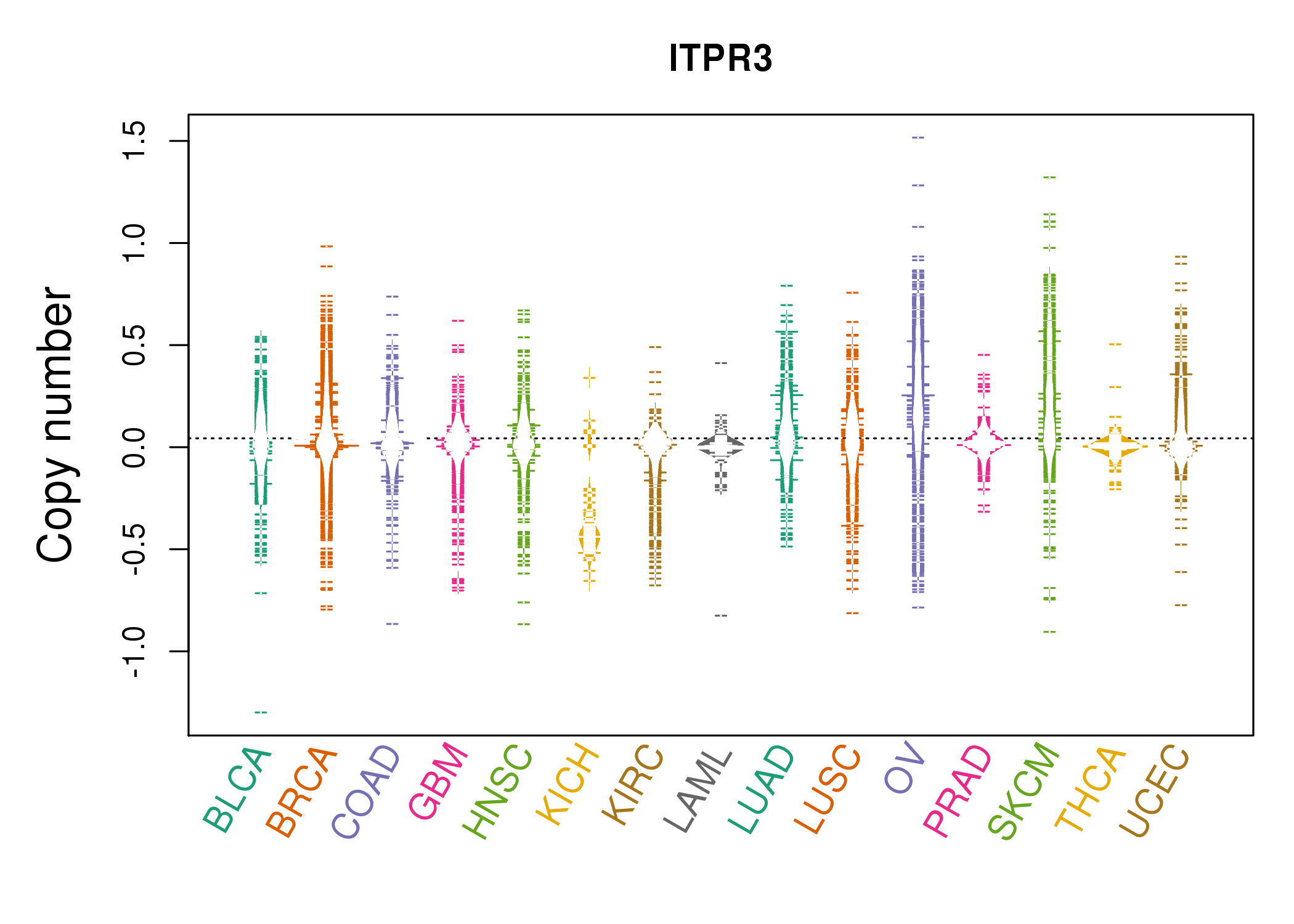 |
| cf) Tissue ID[Tissue type]: BLCA[Bladder Urothelial Carcinoma], BRCA[Breast invasive carcinoma], CESC[Cervical squamous cell carcinoma and endocervical adenocarcinoma], COAD[Colon adenocarcinoma], GBM[Glioblastoma multiforme], Glioma Low Grade, HNSC[Head and Neck squamous cell carcinoma], KICH[Kidney Chromophobe], KIRC[Kidney renal clear cell carcinoma], KIRP[Kidney renal papillary cell carcinoma], LAML[Acute Myeloid Leukemia], LUAD[Lung adenocarcinoma], LUSC[Lung squamous cell carcinoma], OV[Ovarian serous cystadenocarcinoma ], PAAD[Pancreatic adenocarcinoma], PRAD[Prostate adenocarcinoma], SKCM[Skin Cutaneous Melanoma], STAD[Stomach adenocarcinoma], THCA[Thyroid carcinoma], UCEC[Uterine Corpus Endometrial Carcinoma] |
| Top |
| Gene Expression for ITPR3 |
| * CCLE gene expression data were extracted from CCLE_Expression_Entrez_2012-10-18.res: Gene-centric RMA-normalized mRNA expression data. |
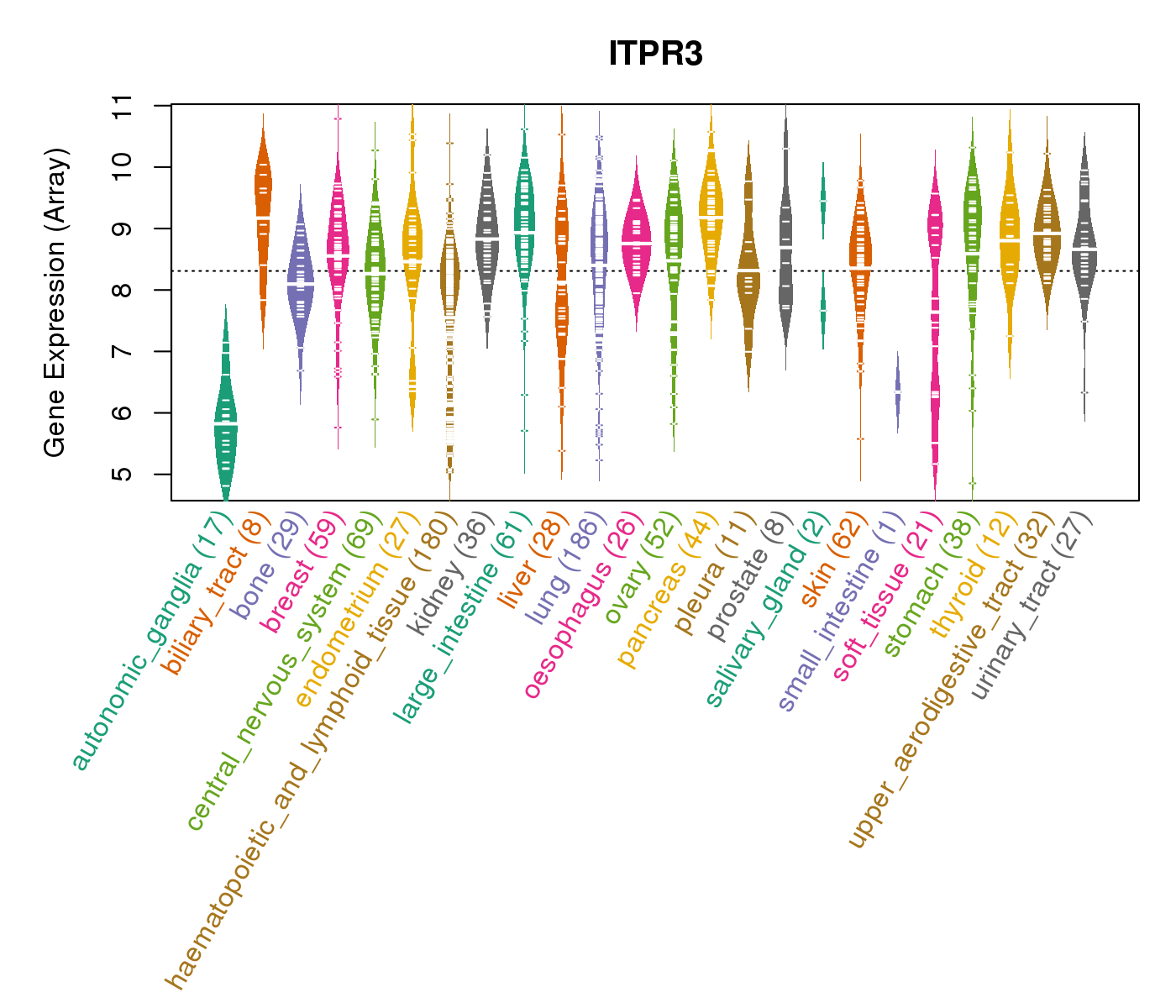 |
| * Normalized gene expression data of RNASeqV2 was extracted from TCGA using R package TCGA-Assembler. The URLs of all public data files on TCGA DCC data server were gathered at Jan-05-2015. Only eight cancer types have enough normal control samples for differential expression analysis. (t test, adjusted p<0.05 (using Benjamini-Hochberg FDR)) |
 |
| Top |
| * This plots show the correlation between CNV and gene expression. |
: Open all plots for all cancer types
 |
|
 |
|
| Top |
| Gene-Gene Network Information |
| * Co-Expression network figures were drawn using R package igraph. Only the top 20 genes with the highest correlations were shown. Red circle: input gene, orange circle: cell metabolism gene, sky circle: other gene |
: Open all plots for all cancer types
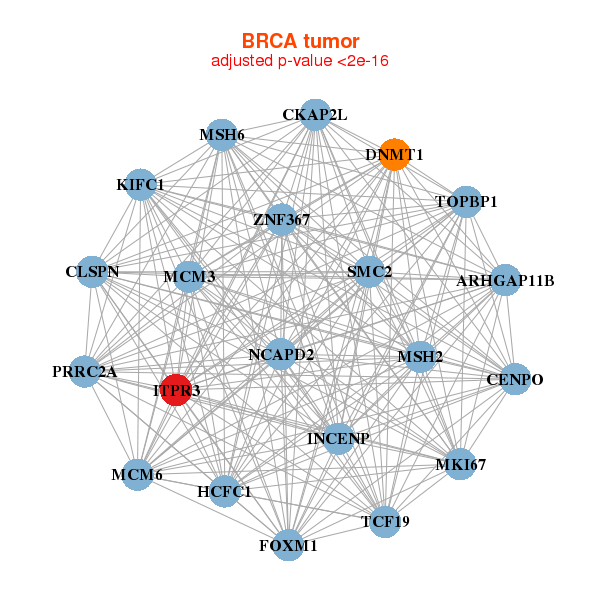 |
|
| ARHGAP11B,PRRC2A,CENPO,CKAP2L,CLSPN,DNMT1,FOXM1, HCFC1,INCENP,ITPR3,KIFC1,MCM3,MCM6,MKI67, MSH2,MSH6,NCAPD2,SMC2,TCF19,TOPBP1,ZNF367 | CCDC57,DNMT1,ESRP2,ITPR3,KDM5C,KIAA0556,KIAA1244, MST1R,MYO19,NBEAL2,PIGO,RAI1,SEC16A,SEC24C, SLC26A1,SPATA13,SPTBN2,SRCAP,TRIM36,ZNF710,ZSWIM5 |
 |
|
| ANKRD11,ANKS1A,PRR14L,CASZ1,DOT1L,GNA11,GOLGA4, IQGAP3,ITPR3,CEP170B,MYO18A,PCNT,PLEKHA7,RREB1, SPEN,SRRM2,TMEM63B,UBR2,UBR4,ZNF318,ZZEF1 | AP1B1,ARHGAP32,PRR14L,CLEC16A,CNOT1,DSP,EXT1, GAK,ITGB4,ITPR3,AREL1,MYH14,MYO18A,PCNXL3, PDPK1,PLXNA2,RAB11FIP4,RRBP1,RREB1,TRAPPC10,ZZEF1 |
| * Co-Expression network figures were drawn using R package igraph. Only the top 20 genes with the highest correlations were shown. Red circle: input gene, orange circle: cell metabolism gene, sky circle: other gene |
: Open all plots for all cancer types
| Top |
: Open all interacting genes' information including KEGG pathway for all interacting genes from DAVID
| Top |
| Pharmacological Information for ITPR3 |
| There's no related Drug. |
| Top |
| Cross referenced IDs for ITPR3 |
| * We obtained these cross-references from Uniprot database. It covers 150 different DBs, 18 categories. http://www.uniprot.org/help/cross_references_section |
: Open all cross reference information
|
Copyright © 2016-Present - The Univsersity of Texas Health Science Center at Houston @ |






